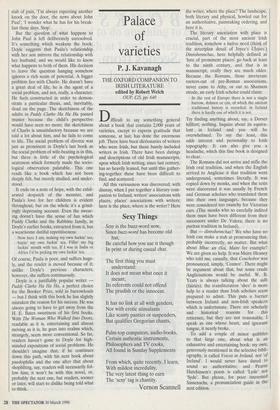Palace of varieties
P. J. Kavanagh
THE OXFORD COMPANION TO IRISH LITERATURE edited by Robert Welch OUP, US, pp. 640 Difficult to say something general about a book that contains 2,000 years of varieties, except to express gratitude that someone, at last, has done the enormous job. There have been dictionaries of writers who were Irish, but these barely included writers in Irish. There have been datings and descriptions of old Irish manuscripts, upon which Irish writing, since last century, has so heavily leaned, but until this gather- ing-together these have been difficult to find, and scattered.
All this variousness was discovered, with dismay, when I put together a literary com- panion to Ireland; writers' associations with places, places' associations with writers; here is the place, where is the writer? Here the writer, where the place? The landscape, both literary and physical, howled out for an authoritative, painstaking ordering, and here it is.
The literary association with place is crucial, part of the most ancient Irish tradition, somehow a native need (think of the streetplan detail of Joyce's Ulysses.) Dinnshennchas, here helpfully defined as 'lore of prominent places' go back at least to the ninth century, and that is in manuscript; orally they are much older. Because the Romans, those inveterate rooters-out of pre-Roman associations, never came to Athy, or out to Shannon strode, an early Irish scholar could claim: In the rest of Europe there is not a single barrow, dolmen or cist, of which the ancient traditional history is recorded; in Ireland there is hardly one of which it is not.
Try finding anything about, say, a Dorset hillfort; nothing. Inquire about its equiva- lent in Ireland and you will be overwhelmed. To say the least, this adds interest and personality to Irish topography. It can also give you a headache, which this fine book is designed to clear.
The Romans did not arrive and stifle the Irish oral tradition, and when the English arrived to Anglicise it that tradition went underground, sometimes literally. It was copied down by monks, and when the texts were discovered it was usually by French and German scholars who translated them into their own languages, because they were considered too raunchy for Victorian ears. (The monks who so carefully indited them must have been different from their successors under De Valera; there is no puritan tradition in Ireland).
But — dinnshennchas? We who have no Irish can make a stab at pronouncing that, probably incorrectly, no matter. But what about Mhac an tSoi, Maire for example? We are given no help. It was Maire Heaney who told me, casually, that Conchobor was pronounced, simply, 'Connor'. There might be argument about that, but some crude Anglicisations would be useful. W. B. Yeats is always talking about the sidh (fairies); the transliteration `shee' is more help to a reader than Irish scholars seem prepared to admit. This puts a barrier between Ireland and non-Irish speakers which is unfortunate. There are scholarly and historical reasons for this reticence, but they are not reasonable. I speak as one whose heart, and ignorant tongue, it nearly broke.
To add a couple of minor quibbles to that large one, about what is an exhaustive and entertaining book: my own, generously mentioned in the selective bibli- ography, is called Voices in Ireland, not 'of Ireland'. I would never have dared to sound so authoritative; and Pearse Hutchinson's poem is called `Lyde' not `Syde'. But please, for poor interested Sassenachs, a pronunciation guide in the next edition.


























































 Previous page
Previous page